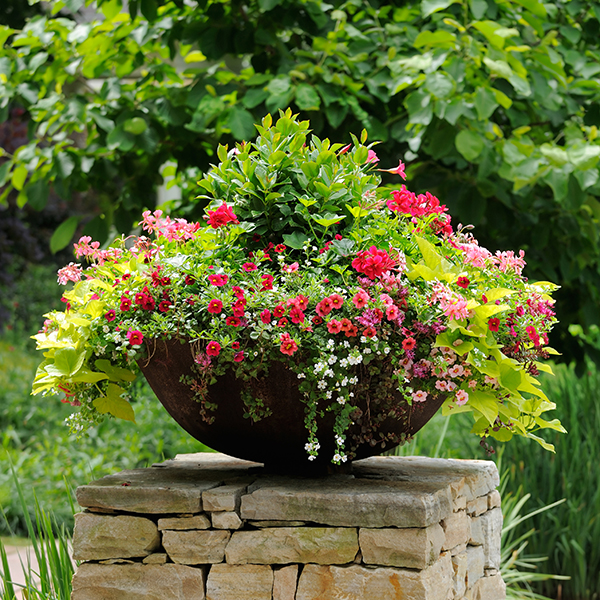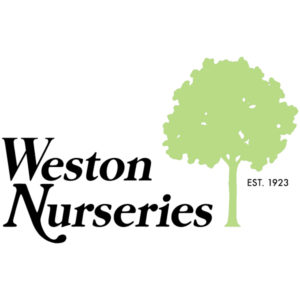Containers planted with a single species — rosemary or a bold variegated ornamental grass, for example — can be stunning garden accents. Containers planted with a mix of plants are fun to create and offer almost unlimited possibilities of combinations. The best combinations depend on plants that feature handsome foliage and flowers produced over a long bloom season.
One easy guideline for choosing the plants to combine in a container is to include “a thriller, a spiller, and a filler.” That translates to at least one focal-point plant (the thriller), such as coleus or a geranium with multicolored leaves, for example, combined with several plants that spill over the edge of the pots — such as petunias, bacopa, creeping zinnias, or ornamental sweet potatoes. Finally, add the fillers, which are plants with smaller leaves and flowers that add color and fill in the arrangement all season long. Good fillers include salvias, verbenas, ornamental peppers, and wax begonias, as well as foliage plants like parsley or licorice plants. You may also want to include a plant for height, such as purple fountain grass. Add a trellis or pillar to a container and you can use a vine to add height to the composition. You’ll need a total of five or six plants for an 18- or 24-inch container, for example.
Container Sizes
Keep in mind that it’s easier to grow plants in large containers than small ones. That’s because large containers hold more soil, which stays moist longer and resists rapid temperature fluctuations. Small hanging baskets are especially prone to drying out, and during hot summer weather, you may have to water them twice a day to keep plants alive.
It’s also important to decide what plant you want to grow in each container. Several factors help determine how large and deep the container must be. Consider the size and shape of a plant’s root system; whether it is a perennial, annual, or shrub; and how rapidly it grows. Rootbound plants, which have filled up every square inch of the soil available, dry out rapidly and won’t grow well. Choose a large pot or tub for a mixed planting, one that will offer enough root space for all the plants you want to grow. Light-colored containers keep the soil cooler than dark containers.
The maximum size (and weight) of a container is limited by how much room you have, what will support it, and whether or not you plan to move it. If your container garden is located on a balcony or deck, be sure to check how much weight the structure will safely hold.
Container Drainage
Whatever container you choose, drainage holes are essential. Without drainage, soil will become waterlogged and plants may die. The holes need not be large, but there must be enough that excess water can drain out. If a container has no holes, try drilling some yourself. A container without holes is best used as a cachepot, or cover, to hide a plain pot. Cachepots (with holes and without them) are useful for managing large plants and heavy pots: Grow your plant in an ordinary nursery pot that fits inside a decorative cachepot so you can move them separately.
Self-watering, double-walled containers, hanging baskets, and window boxes are available. These are useful options for dealing with smaller plants that need frequent watering.
Container Materials
Each type of container has merits and disadvantages:
Clay or terracotta containers are attractive but breakable and easily damaged by freezing and thawing. In Northern areas, most need to be stored in a frost-free location to prevent cracking and are not suitable for hardy perennials or shrubs that will be kept outdoors year-round.
Cast concrete is long-lasting and comes in a range of sizes and styles. These can be left outside in all weather. You can even make attractive ones yourself. Plain concrete containers are very heavy, so they are difficult to move and not suitable for using on decks or balconies. Concrete mixed with vermiculite or perlite, or concrete and fiberglass blends, are much lighter. For a lighter pot with a concrete look, go with hypertufa.
Plastic and fiberglass pots and planters are lightweight, relatively inexpensive, and available in many sizes and shapes. Choose sturdy and somewhat flexible containers and avoid thin, stiff ones — they become brittle with cold or age.
Containers made of polyurethane foam weigh up to 90% less than terracotta or concrete containers, yet they look remarkably like their much-heavier cousins. Polyurethane foam containers resist chipping and cracking and also insulate roots against both hot and cold temperatures, making them a good choice for potting up plants that will stay outside year-round.
Wood is natural-looking and protects roots from rapid temperature swings. You can build wooden planters yourself. Choose a naturally rot-resistant wood such as cedar or locust, or use pine treated with a preservative. (Don’t use creosote, which is toxic to plants.) Molded wood-fiber containers are sturdy and inexpensive.
Metals are strong, but they conduct heat, exposing roots to rapid temperature fluctuations.
Container Preparation
Since containers are heavy once they’re filled with soil, decide where they will be located and move them into position before filling and planting. If keeping them watered during the day is a problem, look for sites that receive morning sun but get shaded during the hottest part of the day, even if you’re growing plants for full sun. Afternoon shade will reduce the amount of moisture plants need.
While your containers must have drainage holes, it’s not necessary to cover the holes with pot shards or gravel before you add potting mix. The covering won’t improve drainage, and pot shards may actually block the holes. Instead, prevent soil from washing out by placing a layer of paper towel or newspaper over the holes before adding mix. If your container is too deep, you can put a layer of gravel or Styrofoam in the bottom to reduce the amount of potting soil required.
Plain garden soil is too dense for container gardening. For containers up to 1 gallon in size, use a houseplant soil mixture. For larger containers, use a relatively coarse soilless planting mixture to maintain the needed water and air balance.
Pre-moisten soil either by watering it before you fill containers or by flooding the containers with water several times and stirring. Be sure the soil is uniformly moist before planting.
If you are planting a mixed container, ignore spacing requirements and plant densely; you will need to prune plants once they fill in. For trees and shrubs, trim off any circling roots and cover the root ball to the same level as it was set at the nursery. Firm the planter mixture gently and settle by watering thoroughly. Don’t fill pots level to the top with soil mixture — leave space for watering.
Selecting Plants for Containers
Almost any vegetable, flower, herb, shrub, or small tree can grow successfully in a container. Dwarf and compact cultivars are best, especially for smaller pots. Select plants to suit the climate and the amount of sun or shade the container will receive. If you are growing fragrant plants, such as heliotrope (Heliotropium arborescens), place containers in a site protected from breezes, which will disperse the perfume.
Use your imagination and combine upright and trailing plants, edibles, and flowers for pleasing and colorful effects. Container gardening can be enjoyed for one season and discarded, or designed to last for years. When designing permanent containers, remember that the plants will be less hardy than usual because their roots are more exposed to fluctuating air temperature. Nonhardy plants will need to have winter protection or be moved to a sheltered space. So consider how heavy the container will be and decide how you will move it before choosing a nonhardy plant.
Vegetables and Herbs
You can grow vegetables in individual containers — from large pots to 5-gallon buckets or half barrels, the largest of which will accommodate a single tomato plant or several smaller vegetables such as broccoli or cabbage. Dwarf or bush forms of larger vegetables such as tomatoes, pumpkins, and winter squash are most suited to container gardening.
Theme gardens also are fun to try. Plant a salad garden with colorful lettuces, dwarf tomatoes, chives, and parsley. Or perhaps try a pizza garden, with different types of basil, plus tomatoes and peppers. Or plant a container with edible flowers such as marigolds, pansies (Viola × wittrockiana), and nasturtiums (Tropaeolum majus).
Annuals
For containers that remain attractive all summer long, look for warm-weather annuals that bloom all summer or have foliage that remains attractive. Geraniums, marigolds, wax begonias, coleus (Solenostemon scutellarioides), scarlet sage (Salvia splendens), and flowering tobacco (Nicotiana spp.) are all good choices, but you will find many, many more in garden centers and seed catalogs. Experiment, and if one plant doesn’t work out, don’t worry about it — just cut it down and try something else. For large containers, dwarf cannas and dwarf dahlias also make satisfying additions.
Perennials and Shrubs
Containers planted with hardy perennials and shrubs can be grown and enjoyed from year to year. Hostas and daylilies are great container gardening plants, but many other perennials work as well. Try ferns, European wild ginger (Asarum europaeum), sedges (Carex spp.), lavender, lamiums (Lamium maculatum), sedums, and lungworts (Pulmonaria spp.). Ornamental grasses are great in container gardening, too, as are dwarf conifers and small shrubs.
Container Gardening Care
Water container plants thoroughly. How often depends on many factors such as weather, plant size, and pot size. Don’t let soil in containers dry out completely, as it is hard to rewet. To keep large containers attractive, spread a layer of mulch as you would in the garden. This will also help retain moisture. Be sure to keep mulch an inch or so away from plant stems.
Container gardening plants need regular feeding. Fertilize them by watering with diluted fish emulsion, seaweed extract, or compost tea. Or foliar feed by spraying the leaves with doubly diluted preparations of these solutions. Start by feeding once every two weeks; adjust the frequency depending on plant response.
Since containers are focal points in the garden, you will probably want to give them special attention to keep them looking their best. Remove tattered leaves and deadhead spent flowers. Prune back plants that get leggy or stop blooming. To keep mixed pots attractive, dig out or cut back any plants that don’t grow well or that clash. You can add something else or let other plants in the container fill the space. Keep an eye out for pests like aphids and mites.
The Editors at GoodHousekeeping.com








